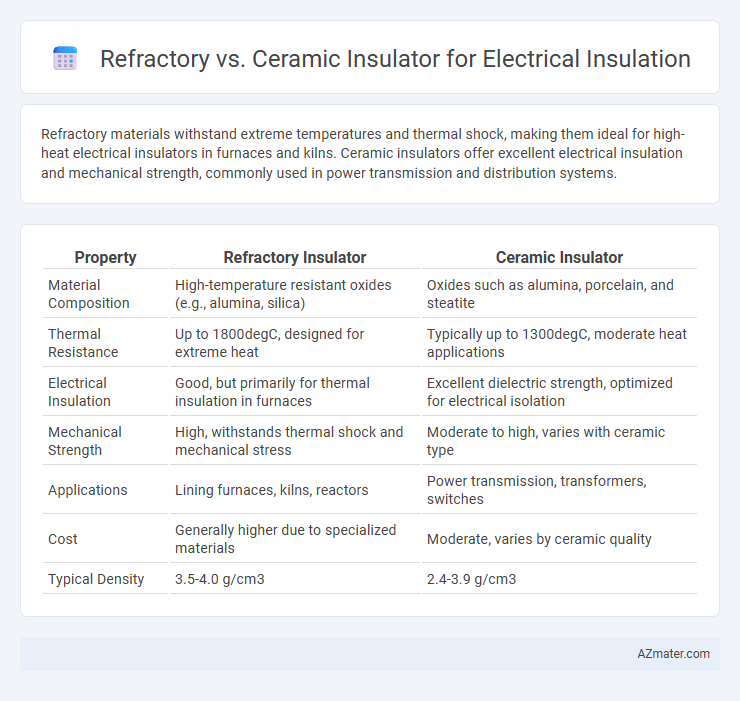Refractory materials withstand extreme temperatures and thermal shock, making them ideal for high-heat electrical insulators in furnaces and kilns. Ceramic insulators offer excellent electrical insulation and mechanical strength, commonly used in power transmission and distribution systems.
Table of Comparison
| Property | Refractory Insulator | Ceramic Insulator |
|---|---|---|
| Material Composition | High-temperature resistant oxides (e.g., alumina, silica) | Oxides such as alumina, porcelain, and steatite |
| Thermal Resistance | Up to 1800degC, designed for extreme heat | Typically up to 1300degC, moderate heat applications |
| Electrical Insulation | Good, but primarily for thermal insulation in furnaces | Excellent dielectric strength, optimized for electrical isolation |
| Mechanical Strength | High, withstands thermal shock and mechanical stress | Moderate to high, varies with ceramic type |
| Applications | Lining furnaces, kilns, reactors | Power transmission, transformers, switches |
| Cost | Generally higher due to specialized materials | Moderate, varies by ceramic quality |
| Typical Density | 3.5-4.0 g/cm3 | 2.4-3.9 g/cm3 |
Introduction to Electrical Insulators
Electrical insulators, essential for preventing unwanted current flow and ensuring safety in power systems, vary significantly between refractory and ceramic types. Refractory insulators, composed of heat-resistant materials like alumina or silica, excel in high-temperature environments commonly found in industrial applications. Ceramic insulators, typically made from porcelain or advanced composites, offer superior dielectric strength and mechanical robustness, making them ideal for outdoor and high-voltage electrical insulation.
Defining Refractory and Ceramic Insulators
Refractory insulators are materials designed to withstand extremely high temperatures and harsh thermal environments, typically composed of oxide or non-oxide ceramics such as alumina or silicon carbide. Ceramic insulators, primarily made from alumina, steatite, or porcelain, offer excellent electrical insulation properties, mechanical strength, and chemical stability at elevated temperatures. The key difference lies in refractory insulators' superior thermal resistance for use in furnaces and kilns, whereas ceramic insulators focus on maintaining dielectric strength in electrical power systems.
Material Composition and Structure
Refractory insulators primarily consist of high-alumina and silica materials designed to withstand extreme temperatures and thermal shock, featuring a dense, crystalline structure for durability in harsh environments. Ceramic insulators are typically composed of alumina, silicon carbide, or porcelain with a microstructure optimized for electrical insulation and mechanical strength, combining vitrified or glazed surfaces to enhance dielectric performance and corrosion resistance. The material composition of refractory insulators prioritizes thermal stability, while ceramic insulators emphasize electrical insulation properties, influencing their respective structural designs and applications in electrical systems.
Key Physical and Chemical Properties
Refractory insulators exhibit high melting points above 1500degC and exceptional thermal shock resistance, making them ideal for extreme heat applications, while ceramic insulators, typically composed of alumina or silica, offer superior electrical insulation and mechanical strength under moderate temperatures. Chemically, refractory materials resist oxidation and corrosion in harsh environments, whereas ceramic insulators provide excellent dielectric properties and chemical stability in acidic or alkaline conditions. Both types maintain low thermal conductivity, but ceramics display better dimensional stability and hardness, enhancing their durability in electrical insulation tasks.
Performance in High-Temperature Environments
Refractory insulators excel in high-temperature environments due to their ability to withstand extreme heat without deformation, making them ideal for applications above 1500degC. Ceramic insulators provide excellent electrical insulation and thermal resistance up to approximately 1200degC, with superior resistance to thermal shock and chemical corrosion. Performance selection depends on specific temperature ranges and environmental conditions where refractory materials offer durability at ultra-high temperatures and ceramics balance insulation and mechanical strength.
Electrical Insulation Capabilities
Refractory insulators excel in high-temperature electrical insulation, maintaining stability and dielectric strength under extreme thermal conditions, making them ideal for applications like furnaces and kilns. Ceramic insulators offer superior electrical insulation with excellent resistance to moisture, chemical corrosion, and electrical breakdown, suitable for outdoor and high-voltage environments. Both materials provide robust electrical insulation capabilities, but ceramic insulators are preferred for high-voltage and environmental resilience, while refractory insulators are optimal for high-temperature operational stability.
Durability and Lifespan Comparison
Refractory insulators exhibit exceptional durability in high-temperature and harsh environments due to their thermal stability and resistance to chemical corrosion, making them ideal for applications involving extreme heat. Ceramic insulators, while also durable and resistant to electrical and thermal stresses, generally offer a longer lifespan in moderate temperature conditions due to their intrinsic hardness and low moisture absorption. Comparing the two, refractory insulators excel in prolonged exposure to intense heat, whereas ceramic insulators provide superior longevity under standard electrical insulation demands.
Cost and Availability Factors
Refractory insulators generally offer lower initial costs compared to ceramic insulators due to simpler manufacturing processes and abundant raw materials like alumina and silica. Ceramic insulators, while more expensive upfront, provide superior durability and long-term reliability which can reduce replacement frequency and maintenance expenses. Availability of refractory materials is widespread and often localized, whereas ceramic insulators depend on more specialized production facilities that can impact delivery times and overall expense.
Typical Applications in Industry
Refractory insulators are widely used in high-temperature industrial processes such as steelmaking, glass manufacturing, and cement production due to their excellent thermal resistance and durability. Ceramic insulators find typical applications in electrical power systems, including transformers, switchgear, and high-voltage transmission lines, where they provide superior dielectric strength and mechanical stability. Both materials are essential in industries requiring reliable insulation under extreme conditions, with refractory insulators favored for heat-intensive environments and ceramic insulators preferred for high-voltage electrical insulation.
Selecting the Right Insulator: Refractory vs Ceramic
Selecting the right electrical insulator depends on the application's temperature tolerance and mechanical strength requirements. Refractory insulators excel in high-temperature environments above 1000degC due to their superior thermal stability and resistance to chemical attack, making them ideal for industrial furnaces and kilns. Ceramic insulators, offering excellent electrical insulation and mechanical robustness below 1000degC, are preferred in electrical transmission and distribution systems where durability and insulating properties are critical.

Infographic: Refractory vs Ceramic insulator for Electrical insulator
 azmater.com
azmater.com